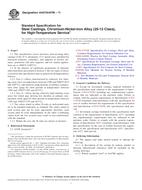We need your consent to use the individual data so that you can see information about your interests, among other things. Click "OK" to give your consent.
ASTM A447/A447M-11
Standard Specification for Steel Castings, Chromium-Nickel-Iron Alloy (25-12 Class), for High-Temperature Service
STANDARD published on 1.10.2011
The information about the standard:
Designation standards: ASTM A447/A447M-11
Note: WITHDRAWN
Publication date standards: 1.10.2011
SKU: NS-2506
The number of pages: 4
Approximate weight : 12 g (0.03 lbs)
Country: American technical standard
Category: Technical standards ASTM
The category - similar standards:
Annotation of standard text ASTM A447/A447M-11 :
Keywords:
ausenitic stainless steel, high temperature applications, stainless steel, steel castings, Chromium alloy steel castings--specifications, Chromium-nickel-iron alloys, High-temperature service applications--steel castings, Steel castings--specifications, Structural steel (SS) castings--specifications, ICS Number Code 77.140.80 (Iron and steel castings)
Additional information
| 1. Scope | ||||||||||||
|
1.1 This specification covers iron-base, heat-resisting alloy castings of the 25 % chromium, 12 % nickel class, intended for structural elements, containers, and supports in electric furnaces, petroleum still tube supports, and for similar applications up to 2000°F [1095°C]. The purchaser should inform the manufacturer when the service temperatures are to exceed 1800°F [980°C]. 1.2 In the absence of significant proportions of elements other than those prescribed in Section 4, the two types of alloys covered by this specification may in general be distinguished as follows: 1.2.1 Type I—Alloys characterized by relatively low limiting creep stress at temperatures between 1500 and 2000°F [815 and 1095°C], and relatively high ductility at ordinary temperatures after aging for short periods at temperatures between 1300 and 1500°F [705 and 815°C]. 1.2.2 Type II—Alloys having relatively high limiting creep stress but which may develop low ductility at ordinary temperatures when aged for short periods at temperatures between 1350 and 1500°F [730 and 815°C]. 1.3 The values stated in either SI units or inch-pound units are to be regarded separately as standard. The values stated in each system may not be exact equivalents; therefore, each system shall be used independently of the other. Combining values from the two systems may result in non-conformance with the standard. 1.3.1 Within the text, the SI units are shown in brackets. 1.4 This standard does not purport to address all of the safety concerns, if any, associated with its use. It is the responsibility of the user of this standard to establish appropriate safety and health practices and determine the applicability of regulatory limitations prior to use. |
||||||||||||
| 2. Referenced Documents | ||||||||||||
|
Similar standards:
Historical
1.11.2013
Historical
1.3.2011
Historical
1.5.2014
Historical
1.3.2011
Historical
15.10.2011
Historical
1.5.2014
We recommend:
Technical standards updating
Do you want to make sure you use only the valid technical standards?
We can offer you a solution which will provide you a monthly overview concerning the updating of standards which you use.
Would you like to know more? Look at this page.



 ASTM A27/A27M-13..
ASTM A27/A27M-13.. ASTM A278/A278M-01(2..
ASTM A278/A278M-01(2.. ASTM A297/A297M-14..
ASTM A297/A297M-14.. ASTM A319-71(2011)..
ASTM A319-71(2011).. ASTM A327/A327M-11..
ASTM A327/A327M-11.. ASTM A351/A351M-14..
ASTM A351/A351M-14..
 Cookies
Cookies
